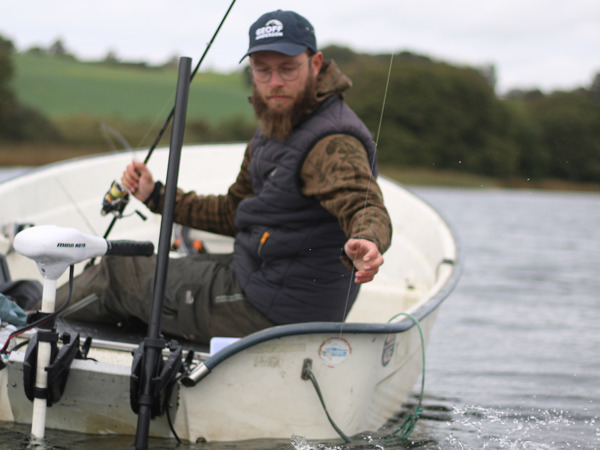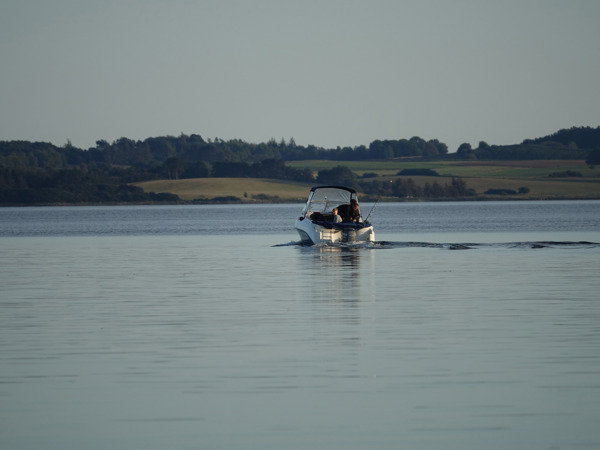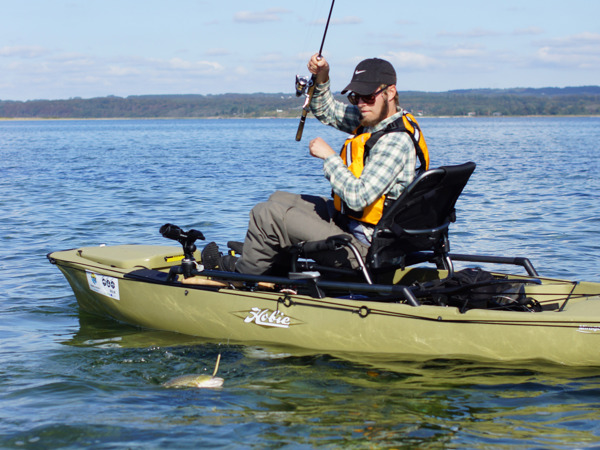 Fishing spots
Fishing guide
Associations and water care
Information and rules
Explore Denmark
Fishing spots
Fishing guide
Associations and water care
Information and rules
Explore Denmark
Fishing from boat, kayak, and float tube offers new experiences and different perspectives from the waterfront, regardless of whether you are fishing on the lake, in the river, or at sea.
Follow your dream of catching a pike, or hop on a cutter to catch a cod for New Year’s Eve. That and much more can come true when fishing from boat, kayak, or float tube. But the adventure doesn’t stop there. On the water, unique nature experiences are created that last a lifetime. Explore uninhabited islands and areas inaccessible on foot. Don’t hesitate; adventure awaits!


Fishing from float tube is very popular, especially for anglers on the lake or coast. You can keep a float tube in the car, and with an electric pump you’ll be water-bound in no time. A float tube opens up for exploring fishing spots from new angles. While fishing on the coast, a float tube enables you to move toward and fish all the hot spots at high water, agitated water, or with a wind direction that is new to you. The float tube is moved via fins attached to your feet, so you can push backwards – easily done while you’re fishing.

The pontoon boat is the luxury version of a float tube, but apart from better comfort and height, you can also be really active between the fishing spots. The larger pontoon boats have room for small electric or outboard motors and are particularly suitable for lakes and coasts. They are also more robust when it’s rainy or windy, which yields more possibilities for fishing in different conditions.

Fishing from tour boat is special. In generations, skippers on fishing cutters have offered fishing trips to the general population, and this has almost become a landmark in large parts of Denmark. The tour boats offer a unique opportunity to get out to sea and enjoy the fresh, salty air while catching a fish for the dinner table.

What is a tour boat?
A tour boat is most often a larger boat or a cutter sailing to catch fish by rod on the ocean. Cod, pollack, saithe, and flatfish are most often on the menu. In the past, these fishermen practiced commercial fishing with rod, but today the traditional rod fishing has quite the recreational value instead.
When the tour boats set out from the harbors, it’s most often with a fresh fish for the frying pan in mind. This is why most of the fishing targets good eating fish, which are easily accessible by boat. Cod and partially flatfish are most interesting in this context, as they are found almost everywhere. If you are more hardcore, trips out on the Skagerrak for ling, saithe, pollack, catfish, and many other exciting species can be arranged.


Fishing from pontoon, float tube, or fishing kayak can be very exciting and educational. Suddenly you can experience fishing from a brand new perspective.

Fishing from a smaller boat or a dinghy is a beloved activity by many anglers. Whether you like lakes or the ocean, the simple or the nerdy, boat fishing is sure to trigger a fishing fever as well as great memories, not least.

A dinghy for lake fishing is about 10-14 ft. long with a small gas or electric engine. When lake fishing by boat, you’ll often happen upon the three most common predatory fish in the lakes: Pike, perch, and sander. These are the fish most frequently fished for from dinghy in Denmark.
Boat fishing also offers the type of fishing called trolling, where you drag wobblers, rubber lures, or natural bait behind the boat, hoping to get the lake predators to bite.

Sea fishing by boat is every angler’s go-to, if he or she seeks fun fishing while also catching some fresh fish to put on the frying pan. Sea fishing by dinghy is incredibly versatile, as it offers many different types of fishing and fish. As described in the section on fishing by tour boat, there is almost no limit as to the number of species available to you. These include flatfish, cod, mackerel, herring, salmon, and many others.
A special mention has to go to trolling for salmon around Zealand, Møn, and Bornholm as an incredible experience. The salmon of the Baltic Sea have good conditions in the brackish water triangle between the aforementioned islands. Here, the salmon eat large schools of herring and sprat till it’s fat. The annual tournament on Bornholm called “Trolling Master Bornholm” attracts thousands of eager trolling fishermen and over 400 boats every year, and it’s one of the biggest trolling tournaments in Europe. Trophy fish weighing over 20 kilograms are caught each year.

Coast fishing by boat is pure magic. Most often you’ll fish for the shiny sea trout along the Danish coasts by casting with spoons, flies, or trolling.
Coast fishing by boat is underrated and can be immensely effective, primarily because you can quickly move from one spot to the next and thereby cover most of the coast. Often you will anchor up, jump to land, and fish along the coast, which is optimal in most cases, as this is where the sea trout live. In certain situations, fishing from the boat is also effective if you find reef housing fish farther out.
The sea trout can be deemed our national fish, since it’s unique to Denmark. Here it thrives like no other place in the world, and thus it’s quite exceptional that we have so many accessible coasts booming with sea trout.
Casting
There are many possible types of casting for pike. Some of the most popular lures are spinners, wobblers, jerkbait, and shads. The pike is quite responsive to sounds, motions, and vibrations. When casting, the speed of your lure can be essential. During the cold months, your lure should be slow while it can be a good idea to speed it up during spring, summer, and fall.

Coarse fishing
If you seek calmer fishing, float fishing is just the thing. Put a sinker with two treble hooks attached at the end under the float. The bait fish will typically be a roach attached to the hooks. And when you’re set, all you have to do is kick back and wait in the boat or by the banks.
Vertical jigging can be effective in many types of fishing, especially when fishing for pike, sander, and perch.
If you’re fishing with live bait, use either float or a bottom rig. If you’re using a cork float, it’s important to place the hooks so the pike won’t feel them right away.
Vertical jigging
If you fish for sander by boat in deeper water, vertical jigging is both effective and fun. It’s a very thrilling type of fishing, where you have to keep a level head to lure the sander to bite. In this situation, an echo sounder is an important tool for finding the fish as well as the right depths.
Trolling
You troll from a boat with oars, gas motor, or electric motor. Be aware of local rules at your chosen lake, as not all lakes allow fishing from motor boat.
Trolling with artificial or live bait like roach can be effective in covering a lot of water. Place your bait around 15-30 meters behind the boat for optimal control of your bait. If you’re using more than one rod, keep them at different depths to easier locate the fish – right under the surface, in the middle of the water column, or right at the bottom until you hook your predator fish.
Echo sounder and electronics
For the dinghy angler, thorough knowledge of the depths and bottom conditions of local fishing waters is a major step in the right direction. The depth contours show changes in the bottom conditions that are most important to the fish – namely protection and food prospects.
The shortcut to more and bigger fish is called a combi tool which contains both echo sounder and chart plotter. Having a separate chart plotter and echo sounder is of course also an option, but the advantages are the same. The only difference is the size of the screens. Modern fishing can be a struggle without chart or echo sounder, which is why this article focuses on these exact tools.

Always consider using life jackets and other safety gear